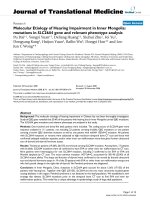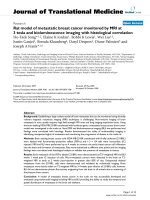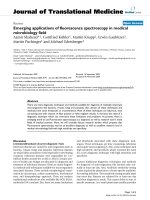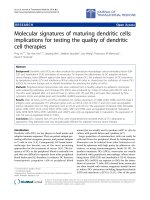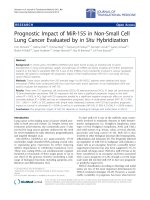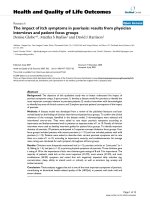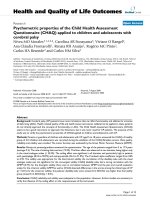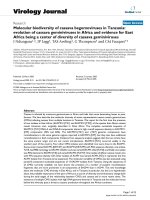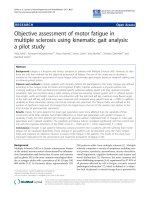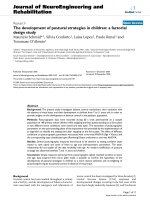báo cáo hóa học:" Molecular Etiology of Hearing Impairment in Inner Mongolia: mutations in SLC26A4 gene and relevant phenotype analysis" ppt
Bạn đang xem bản rút gọn của tài liệu. Xem và tải ngay bản đầy đủ của tài liệu tại đây (1.83 MB, 12 trang )
BioMed Central
Page 1 of 12
(page number not for citation purposes)
Journal of Translational Medicine
Open Access
Research
Molecular Etiology of Hearing Impairment in Inner Mongolia:
mutations in SLC26A4 gene and relevant phenotype analysis
Pu Dai
†1
, Yongyi Yuan
†1
, Deliang Huang
†1
, Xiuhui Zhu
2
, Fei Yu
1
,
Dongyang Kang
1
, Huijun Yuan
1
, Bailin Wu
3
, Dongyi Han*
1
and Lee-
JunCWong*
4
Address:
1
Department of Otolaryngology and Genetic Testing Center for Deafness, Chinese PLA General Hospital, Beijing 100853, PR China,
2
Department of Otolaryngology, Chifeng Second Hospital, Chifeng City (Inner Mongolia), PR China,
3
Division of Genetics and Metabolism,
Children's Hospital Boston, Harvard Medical School, Boston, Massachusetts, USA and
4
Department of Molecular and Human Genetics, Baylor
College of Medicine, Houston, Texas, USA
Email: Pu Dai - ; Yongyi Yuan - ; Deliang Huang - ;
Xiuhui Zhu - ; Fei Yu - ; Dongyang Kang - ;
Huijun Yuan - ; Bailin Wu - ; Dongyi Han* - ; Lee-
Jun C Wong* -
* Corresponding authors †Equal contributors
Abstract
Background: The molecular etiology of hearing impairment in Chinese has not been thoroughly investigated.
Study of GJB2 gene revealed that 30.4% of the patients with hearing loss in Inner Mongolia carried GJB2 mutations.
The SLC26A4 gene mutations and relevant phenotype are analyzed in this study.
Methods: One hundred and thirty-five deaf patients were included. The coding exons of SLC26A4 gene were
sequence analyzed in 111 patients, not including 22 patients carrying bi-allelic GJB2 mutations or one patient
carrying a known GJB2 dominant mutation as well as one patient with mtDNA 1555A>G mutation. All patients
with SLC26A4 mutations or variants were subjected to high resolution temporal bone CT scan and those with
confirmed enlarged vestibular aqueduct and/or other inner ear malformation were then given further ultrasound
scan of thyroid and thyroid hormone assays.
Results: Twenty-six patients (19.26%, 26/135) were found carrying SLC26A4 mutation. Among them, 17 patients
with bi-allelic SLC26A4 mutations were all confirmed to have EVA or other inner ear malformation by CT scan.
Nine patients were heterozygous for one SLC26A4 mutation, including 3 confirmed to be EVA or EVA and
Mondini dysplasia by CT scan. The most common mutation, IVS7-2A>G, accounted for 58.14% (25/43) of all
SLC26A4 mutant alleles. The shape and function of thyroid were confirmed to be normal by thyroid ultrasound
scan and thyroid hormone assays in 19 of the 20 patients with EVA or other inner ear malformation except one
who had cystoid change in the right side of thyroid. No Pendred syndrome was diagnosed.
Conclusion: In Inner Mongolia, China, mutations in SLC26A4 gene account for about 12.6% (17/135) of the
patients with hearing loss. Together with GJB2 (23/135), SLC26A4 are the two most commonly mutated genes
causing deafness in this region. Pendred syndrome is not detected in this deaf population. We established a new
strategy that detects SLC26A4 mutations prior to the temporal bone CT scan to find EVA and inner ear
malformation patients. This model has a unique advantage in epidemiologic study of large deaf population.
Published: 30 November 2008
Journal of Translational Medicine 2008, 6:74 doi:10.1186/1479-5876-6-74
Received: 11 August 2008
Accepted: 30 November 2008
This article is available from: />© 2008 Dai et al; licensee BioMed Central Ltd.
This is an Open Access article distributed under the terms of the Creative Commons Attribution License ( />),
which permits unrestricted use, distribution, and reproduction in any medium, provided the original work is properly cited.
Journal of Translational Medicine 2008, 6:74 />Page 2 of 12
(page number not for citation purposes)
Introduction
Every year in China, about 30,000 children, compared to
840 in UK and one of every one thousand infants in US,
are born with congenital hearing impairment[1-3]. Hear-
ing impairment is the most common neurosensory disor-
der in human that has an incidence of approximately 1 in
1000 children worldwide[4]. About 50–60% of these
cases have a genetic cause. The most common molecular
defects for nonsyndromic autosomal recessive deafness lie
on Connexin 26, a gap junction protein encoded by the
GJB2[5-12]. More than 150 mutations, polymorphisms
and unclassified variants have been described in GJB2 to
account for about 8–40% of molecular etiology of the
patients with nonsyndromic hearing impairment http://
davinci.crg.es/deafness[3]. However, about 80% of the
patients with nonsyndromic hereditary deafness in China
do not have mutations in GJB2[13].
Pendred syndrome (PS) is the most common form of syn-
dromic deafness that accounts for about 10% of heredi-
tary hearing impairment[14]. It is an autosomal recessive
disorder caused by biallelic mutations in SLC26A4 result-
ing in hearing loss, enlargement of the vestibular aque-
duct (EVA) and iodine organification defect in the thyroid
gland[15]. EVA is always detected in the ears of patients
with PS by computed tomography (CT) and magnetic res-
onance imaging (MRI)[16]. EVA is the most common
form of the inner ear malformation associated with
prelingual or postlingual sensorineural hearing loss and is
an important feature of PS[17,18]. EVA may occur alone
or in combination with an incomplete partition of the
apical turn of the cochlea as part of Mondini deformity. PS
is differentiated from nonsyndromic hearing loss with
EVA by the presence of goiter, which usually develops
later at around the time of puberty. Since environmental
and other genetic factors may modulate the effects of
SLC26A4 mutations on the development of goiter, the
expression of goiter in PS patients is variable and may
have incomplete penetrance[19]. SLC26A4 encodes an
anion (chloride/iodide) transporter transmembrane pro-
tein, pendrin, which is expressed in the thyroid, kidney,
and cochlea[20,21]. DNA sequence analysis identified
more than 100 different mutations in SLC26A4[10,15,22-
27]. The mutation spectrum varies widely among different
ethnic groups[10,15,19,23,26-30]. Park and Pryor
observed that patients with PS were always associated
with two mutant alleles in SLC26A4 consistent with auto-
somal recessive disorder, whereas patients with nonsyn-
dromic hearing loss and EVA might have one or zero
mutant allele[15,19]. In Caucasian nonsyndromic EVA
cohort, about one third of the patients had two mutant
alleles, one third had one mutant allele and one third had
zero[19]. In Japanese and Korean EVA patients, the pro-
portion of patients having two identified mutant alleles in
SLC26A4 is much higher, 57% and 81%, respec-
tively[24,29]. Whereas in China, 97.9% EVA patients in
simplex families were detected with either biallelic or
monoallelic mutations, of which 88.4% were carrying
biallelic variants and 9.5% with monoallelic mutation.
Only 2.1% Chinese EVA patients had no mutant SLC26A4
allele detected[27]. In addition, the prevalent mutations
in different ethnic groups are very different. Campbell et
al. reported T416P and IVS8+1G>A as the two most fre-
quent mutations in northern European population [22],
while Blons et al. showed a completely different mutation
spectrum that was extremely heterogeneous[23]. In Japa-
nese, H723R accounted for 53% of the mutant alleles, and
in Korean, the H723R and the IVS7-2A>G mutation was
the most prevalent mutation accounting for 45.5% of
patients with PS or EVA[19,29]. In China, IVS7-2A>G
mutation was the most common form accounting for
57.63% of the mutant alleles[27]. All of the above studies
focused on the EVA or Pendred syndrome patients.
In order to investigate the ratio of EVA or Pendred syn-
drome in Chinese hearing impairment patients and pro-
vide effective genetic testing and accurate counseling for
hearing loss patients and families in China, we performed
SLC26A4 sequence analysis in hearing impairment
patients in Chifeng City from Inner Mongolia and then
made a genotype-phenotype correlation analysis.
Materials and methods
Patients and DNA samples
A total of 135 deaf students from unrelated families of
Chifeng Special Education School in Inner Mongolia,
China, were included in this study. Among them, 73
patients suffered pre-lingual hearing impairment and 28
patients suffered post-lingual hearing impairment. The
onset of deafness of 34 patients was unclear. Chifeng City
Special Education School is the only deaf mute school in
this area. All students with moderate to profound hearing
loss from Chifeng city and within 500 km diameter of its
neighboring area come to this school. This cohort of
patients consists of 85 male and 50 female from 3 to 20
years old with the average age of 13.2 ± 3.6. The patients
include 94 of Han, 31 of Mongolian, 7 of Man, and 3 of
Hui races. This study was performed according to a proto-
col approved by the ethnicity committee of the Chinese
PLA General Hospital. Informed consent was obtained
from all parents prior to blood sampling. Parents were
interviewed for age of onset, family history, mother's health
condition during pregnancy and patient's clinical history
including infection, possible head or brain injury and the
usage of aminoglycoside antibiotics. In addition, 50 (race
matched) controls with normal hearing were screened for
SLC26A4 mutations by DHPLC followed by sequencing
analysis. DNA was extracted from peripheral blood leuko-
cytes using commercially available DNA extraction kit
(Watson Biotechnologies Inc, Shanghai, China).
Journal of Translational Medicine 2008, 6:74 />Page 3 of 12
(page number not for citation purposes)
Mutational analysis
DNA sequence analysis of GJB2, mitochondrial 12S rRNA
and SLC26A4 were performed by PCR amplification of
the coding exons plus approximated 50–100 bp of the
flanking intron regions followed by Big Dye sequencing
and analysis using ABI 3100 DNA sequencing machine
(ABI, Foster City, USA.) and ABI 3100 Analysis Software
v.3.7 NT according to manufacturer's procedures. Patients
with two GJB2 mutant alleles (22 cases) or one dominant
mutant allele (one case) or mtDNA 1555 A>G mutation
(one case) were not further analyzed for SLC26A4 muta-
tions. The exons of SLC26A4 of the remaining 111
patients were sequenced one by one starting from the fre-
quently mutated exons until 2 mutant alleles were identi-
fied.
CT scan and thyroid examination
Twenty-nine of 32 individuals who had mutations or var-
iants in SLC26A4 were subjected to temporal bone com-
puterized tomography (CT) scan for the diagnosis of EVA
or inner ear malformation based on the criteria of a diam-
eter of greater than 1.5 mm at the midpoint between the
common crus and the external aperture[31]. To evaluate
for Pendred syndrome, the ultrasound scan of thyroid and
the thyroid hormone levels were measured in the patients
positive for SLC26A4 mutations or variants. These proce-
dures were performed at the Second Hospital of Chifeng
City, Inner Mongolia, China. Ten patients with hyperthy-
roidism but normal hearing were enrolled as positive con-
trol for ultrasound scan of the thyroid and the levels of
thyroid hormone. Since perchlorate discharge testing was
not a general clinical practice in China, it was not used in
this study.
Results
All patients showed severe to profound bilateral sen-
sorineural hearing impairment on audiograms except
Patient 9 in Table 1 whose right ear pure tone average
(PTA) is 55 dB.
Correlation of genotype with age of onset of deafness
The average age of onset of patients with EVA and/or other
inner ear malformation is 1.56 ± 1.23. The average age of
onset of other patients is 0.97 ± 1.42. There is no signifi-
cant statistic difference between the two groups (P value
0.09, t = 1.71). The average age of onset of patients with
SLC26A4 mutations or variants is 1.27 ± 1.10. The average
age of onset of patients without SLC26A4 mutations or
variants is 1.03 ± 1.24. There is no significant statistic dif-
ference between the latter groups (P value 0.46, t = 0.727).
SLC26A4 mutations
Sequence analysis of SLC26A4 in these 111 patients with
hearing impairment identified 16 patients (1 to 16) with
two confirmed pathogenic mutations (Table 1), and one
(Patient 17) with compound heterozygote of two unclas-
sified variants, Y375C and R470H, which are most likely
pathogenic (Table 1). Six patients (19 to 24) carry one
SLC26A4 mutant allele, and two patients (18 and 25)
carry a novel unclassified missense variant, I491T and
L597S, respectively, that are likely pathogenic due to their
evolutionary conservation and conserved amino acid
change. Patient 26 carried V659L, a pathogenic mutation
that has also been found in a patient with EVA (Patient
11). The pathogenicity of V659L is reported by Wang et al.
in Chinese enlarged vestibular aqueduct patients[27].
Each of patients 27 to 29 is heterozygous for an unclassi-
fied missense variant. Patients 27 and 28 carrying a single
conserved amino acid change, I235V and T67S respec-
tively, had normal vestibular aqueducts. These two mis-
sense variants are probably benign. The novel IVS12-6insT
in Patient 29 does not predict a gain or loss of a spice site
when analyzed using programe available on http://
www.fruitfly.org/seq_tools/splice.html. So it is also con-
sidered benign. Thus, mutations in SLC26A4 were identi-
fied in 19.26% (26/135) patients with hearing
impairment in Inner Mongolia, China, 17 with two
mutant alleles and 9 with one mutant allele.
A total of 7 different pathogenic mutations (IVS7-2A>G,
E37X, K77I, S391R, N392Y, T410M, H723R) and 5 most
likely pathogenic novel variants (Y375C, R470H, I491T,
L597S, and H723D) were found. The E37X mutation that
results in a premature stop codon and a truncated protein
of less than 5% in length is predicted to be deleterious.
The H723D mutation is caused by nucleotide substitu-
tion, c.2167C>G, which is predicted to be deleterious
since a milder change at the same amino acid residue,
H723R that has been found to be the most common path-
ogenic mutation in Japanese. Other missense mutations:
K77I, S391R, N392Y, T410M and H723R have been
reported in patients with hearing loss in other stud-
ies[26,27,29].
The most common mutation in our patient cohort is the
aberrant splice site alteration, IVS7-2A>G. Eight patients
were homozygotes, 4 patients were compound heterozy-
gotes with another mutant allele, and 5 were heterozy-
gotes without a second mutant allele. The IVS7-2A>G
mutation accounts for 58.14% (25/43, counting only the
definite pathogenic and most likely pathogenic variants)
of all SLC26A4 mutant alleles (Table 1). These results sug-
gest that a significant proportion (26/135 = 19.26%) of
Chinese hearing impairment has molecular defects in
SLC26A4.
SLC26A4 mutations in control individuals
In order to determine carrier frequency in general popula-
tion, SLC26A4 exons 2–21 of 50 normal hearing individ-
uals were analyzed by DHPLC. One IVS7-2A>G
Journal of Translational Medicine 2008, 6:74 />Page 4 of 12
(page number not for citation purposes)
Table 1: Phenotype and genotype of SLC26A4 gene related hearing impairment in Inner mongilia
Patient
number
Age Genotype Phenotype
Allele 1 Allele 2 CT Age of
onset
Diamete
r (mm)
PTA (L)
(dB)
PTA (R)
(dB)
Thyroid
hormone
US scan
Of
thyroid
Nucleotid
e Change
amino
acid
change
category nucleotid
e change
amino acid
change
category
117IVS7-2aberrant
splicing
pathogenic IVS7-2 aberrant
splicing
pathogenic
a
EVA 0.7 3.28 82. 93 normal normal
217IVS7-2aberrant
splicing
pathogenic IVS7-2 aberrant
splicing
pathogenic EVA 2 3.33 103 106 normal normal
3 9 IVS7-2 aberrant
splicing
pathogenic IVS7-2 aberrant
splicing
pathogenic EVA 2.5 2.73 93 95 Total T3
slightly
elevated
normal
416IVS7-2aberrant
splicing
pathogenic IVS7-2 aberrant
splicing
pathogenic EVA 0 2.73 97 97 normal normal
510IVS7-2aberrant
splicing
pathogenic IVS7-2 aberrant
splicing
pathogenic EVA 1 3.64 76 93 normal normal
614IVS7-2aberrant
splicing
pathogenic IVS7-2 aberrant
splicing
pathogenic EVA 2 2.73 96 83 normal normal
710IVS7-2aberrant
splicing
pathogenic IVS7-2 aberrant
splicing
pathogenic EVA 1 2.0 88 95 normal normal
8 8 IVS7-2 aberrant
splicing
pathogenic IVS7-2 aberrant
splicing
pathogenic EVA 2 1.64 101 95 normal normal
919IVS7-2aberrant
splicing
pathogenic 230A>T K77I pathogenic EVA 4 2.22 71 55 normal normal
10 16 IVS7-2 aberrant
splicing
pathogenic 1229C>T
b
T410M pathogenic EVA 3 4.55 78 77 normal normal
11 14 IVS7-2 aberrant
splicing
pathogenic 1975G>C
b
V659L pathogenic EVA 3 4.19 95 95 normal normal
12 13 IVS7-2 aberrant
splicing
pathogenic 2168A>G H723R pathogenic EVA 3.5 4.55 96 85 normal normal
13 13 2168A>G H723R pathogenic 109G>T E37X,
nonsense
mutation
pathogenic EVA 0 2.89 90 87 normal Cystoid
change
14 19 2168A>G H723R pathogenic 1229C>T
b
T410M pathogenic EVA 1.5 2.44 107 102 normal normal
15 17 2168A>G H723R pathogenic 2167C>G H723D Unclassifi
ed variant
EVA 0.25 5.46 85 100 normal normal
16 14 1173C>A S391R pathogenic 1229C>T
b
T410M pathogenic EVA 0.1 3.33 95 90 normal normal
17 10 1124A>G Y375C Unclassifi
ed variant
1409G>A R470H Unclassifi
ed variant
Vestibular
and cochlear
malformation
0.1
a
NA NA NA NA
18 19 1472T>C I491T Unclassifi
ed variant
EVA and
Mondini
0.6 4.44 100 100 NA NA
Journal of Translational Medicine 2008, 6:74 />Page 5 of 12
(page number not for citation purposes)
19 16 IVS7-2 aberrant
splicing
pathogenic EVA 2 5.46 93 92 Total T3
slightly
elevated
normal
20 10 IVS7-2 aberrant
splicing
pathogenic EVA 2 2.66 76 77 normal normal
21 17 IVS7-2 aberrant
splicing
pathogenic 1905G>A E635E Silent
variant
a
ND 1 84 107 NA NA
22 19 1174A>T N392Y pathogenic ND 0 100 100 NA NA
23 16 IVS7-2 aberrant
splicing
pathogenic
a
nl 1 110 102 NA NA
24 24 IVS7-2 aberrant
splicing
pathogenic nl 1.1 100 100 NA NA
25 19 1790T>C L597S Unclassifi
ed variant
nl 1.2 100 100 NA NA
26 17 1975G>C
b
V659L pathogenic nl 0 98 100 normal normal
27 15 757A>G I253V Unclassifi
ed variant
nl 1 110 108 NA NA
28 17 200C>G T67S Unclassifi
ed variant
nl 1.3 95 100 normal normal
29 13 IVS12-6
insT
Intron
insertion
Unclassifi
ed variant
nl 1 97 100 NA NA
30 16 225C>G L75L Silent
variant
ND 0 110 103 NA NA
31 20 678T>C A226A Silent
variant
nl 1 105 105 NA NA
32 18 1905G>A E635E Silent
variant
nl 0.7 110 110 normal normal
Novel mutations are in bold and italic. nl = normal, EVA = enlarged vestibular aqueduct, ND = not determined, NA = not available, CT = computerized tomography, PTA(L) or (R) = pure tone
average(left) or (R), IVS7 = intravening sequence 7 (intron 7), IVS12 = intravening sequence 12 (intron 12), Diameter = Diameter at the midpoint between the common crus and the external
aperture.
Table 1: Phenotype and genotype of SLC26A4 gene related hearing impairment in Inner mongilia (Continued)
Journal of Translational Medicine 2008, 6:74 />Page 6 of 12
(page number not for citation purposes)
heterozygote and one silent variant 2217A>G (Q739Q)
were found. Although this control population is too small
to reach the final conclusion, the carrier rate of SLC26A4
mutation in northern China is estimated to be about 2%.
Polymorphisms in SLC26A4 gene appear to be rare in gen-
eral population when compared to GJB2 gene.
SLC26A4 polymorphisms
Three novel silent variants were identified; c.1905C>G
(E635E), c.678T>C (A226A) and c.225C>G (L75L). These
silent variants are not detected in the 50 control individu-
als.
Comparison of SLC26A4 mutation spectrum in different
patient population
In Asian population, more than 80% of nonsyndromic
patients with EVA harbored mutations in SLC26A4
[19,27,29,30]. In Taiwan and China, both made up of
>90% Han Chinese, the IVS7-2A>G splice mutation is the
most prevalent. In Japan, H723R is the most prevalent. In
Korea, IVS7-2A>G and H723R are the two most prevalent
mutations. There seems to be a shift of mutation from
IVS7-2A>G to H723R from China to Japan with Korea in
the middle. Each population has its own rare variants that
are not shared (Table 2). Mutations in SLC26A4 is very
diverse in European and US populations without any
prevalent mutations that account for more than 10% of
the alleles in patients with Pendred syndrome or EVA
(Table 2) [15,23,26]. Variants in SLC26A4 gene in Cauca-
sians are rarely overlapped with those found in Asians.
Frequencies of SLC26A4 mutations in nonsyndromic
deafness, EVA, and Pendred syndrome patients
CT scan was performed on 29 of the 32 patients listed in
Table 1. Among them, 20 (69%) had EVA and/or Mondini
dysplasia. Seventeen patients (17/20 = 85%) who har-
bored two mutations in SLC26A4 gene. had EVA, except
one Patient (patient 17, Y375C and R470H) had vestibu-
lar and cochlea malformation. Only 3 out of the 7 patients
who carry one heterozygous mutation had EVA, the other
4 were normal. All patients who were heterozygous for
silent and most likely benign variants were normal on CT
scan (Table 1). Since CT scan was performed after geno-
typing, only patients with SLC26A4 mutations or variants
received CT scan. 100% of our patients with two mutant
alleles (17/17) and only 33.3%(3/9) of patients with one
mutant allele were confirmed to have EVA manifestation.
The frequency of SLC26A4 mutations in our nonsyndro-
mic deafness patients is 19.3% (26/135). Most reported
studies focused on screening SLC26A4 mutations in the
EVA or Pendred syndrome patients but not in the nonsyn-
dromic deafness patients.
Other Asian studies report high frequency of finding
SLC26A4 mutations in patients with EVA, 97.9, 87, 92,
and 68% respectively for mainland China, Taiwanese,
Korean and Japanese [8,27,29,32,33]. The mutation
detection rate in Caucasian EVA patients is much lower,
53 and 40% respectively in UK and Europe [26,34]. In US
population, mutations in SLC26A4 account for about one
third of the nonsyndromic EVA patients [15]. Patients
with Pendred syndrome, however, had higher mutation
detection rate in SLC26A4 gene, 90% in a French study
[23].
CT scan
CT scan revealed EVA and/or other inner ear malforma-
tion in 20 patients. Sixteen patients (1 to16) had EVA and
two pathogenic mutant alleles, consistent with autosomal
recessive disorder caused by bi-allelic loss of function of
pendrin protein (Table 1). Patient 17 had common cystic
cavity of cochlea and vestibule without EVA. She carried
two novel missense variants Y375C and R470H (Figure
1). Patient 18 had enlarged vestibular aqueduct with
Mondini dysplasia (Figure 1). He carried a novel I491T
variant. These results suggest that Y375C, R470H and
I491T are most likely pathogenic. Two patients with one
mutant IVS7-2A>G allele had EVA. CT scan results of
Patients 21 and 22 (heterozygote IVS7-2A>G and N392Y
respectively) were not available (Table 1). The remaining
patients had normal CT scan. Testing of the 3 most fre-
quent mutations, IVS7-2 A>G, H723R and T410M, can
lead to finding 80% of patients with EVA or inner ear mal-
formation in this cohort
Several patients have multiple affected siblings with the
same two mutant alleles supporting that EVA is an auto-
somal recessive disease. For example, two sisters of patient
9 with the same genotype (IVS7-2A>G/K77I) and one sis-
ter of Patient 6 with homozygous IVS7-2A>G all have
EVA. The parents of these two families are normal hearing
individuals and carriers of corresponding SLC26A4 muta-
tions.
Thyroid ultrasound and thyroid hormone assays
Thyroid ultrasound was performed to determine presence
or absence of goitre. None of the patients with SLC26A4
mutations or variants was diagnosed goitre. Only one
patient (Patient 13) with EVA was found cystoid change in
the thyroid by ultrasound scan, while there was no change
in the thyroid hormone levels. Thyroid hormone assays
showed that total T3 was slightly elevated in two patients
(Patient 3 and Patient 19), but this abnormity had no
clinical value when evaluated by endocrinologist from
Chinese PLA General Hospital.
Discussion
Diagnosis of Pendred syndrome EVA requires the evalua-
tion of inner ear malformation by temporal bone CT scan.
Unfortunately, in Chifeng City, Inner Mongolia, China,
Journal of Translational Medicine 2008, 6:74 />Page 7 of 12
(page number not for citation purposes)
Table 2: SLC26A4 mutation spectrum among different populations
a
Chinese
a
Chinese
a
Taiwanese
a
Korean
a
Japanese
a
French
a
Caucasian
European
a
US
a
Total
number of
patients
135 NSHI
(20 EVA)
95 EVA 38 EVA 26 EVA 10 PS + 32
EVA
30 PS 100 EVA 31 PS & EVA
Total mutant
alleles
identified
43 (100) 177(100) 57 (100) 45 (100) 57 (100) 50(100) 64 (100) 32 (100)
% of SLC26A4
mutation in
total
15.92
(43/270)
93.16
(177/190)
75
(57/76)
86.5
(45/52)
67.86
(57/84)
83.33
(50/60)
32(64/200) 51.61(32/62)
IVS7-2A>G 25 (62.5) 102(57.63) 48 (84.2) 9 (20) 2 (3.51)
T410M 3 (7.5) 4(2.26) 1 (1.75) 3 (6) 1(1.56)
K77I 1 (2.5) 1(0.56) 1 (1.75)
H723R 4 (10) 16(9.04) 1 (1.75) 18 (40) 33 (57.9)
H723D 1 (2.5)
S391R 1 (2.5) 1(1.56)
N392Y 1 (2.5) 5(2.82) 1 (1.75)
E37X 1 (2.5) 1(0.56)
I491T 1 (2.5)
Y375C 1 (2.5)
R470H 1 (2.5)
V659L 2(5) 1(0.56)
S448L 1(0.56) 1 (1.75)
T721M 1 (1.75) 1 3 (5.3) 1(2) 2(3.13)
A372V 2 (3.51) 4 (7)
A387V 1(0.56) 2 (3.51)
2111ins5 2 (3.51)
917delT 1 (1.75)
1652insT 1 (1.75)
IVS5-1G>A 1 (1.75)
IVS8+1G>A 1 (1.75) 2(4) 3(4.69) 2(6.25)
322delC 1 (1.75)
S610X 1 (1.75)
C565Y 1 (1.75)
K369E 1 (1.75)
S657N 1 (1.75)
S666F 1 (1.75)
P123S 1 (1.75)
M147V 2(1.13) 3 (6.67) 1 (1.75)
IVS9+3A>G 4 (8.89)
365insT 2 (4.44)
S28R 1 (2.22)
IVS4+4A>G 1 (2.22)
P142R 1 (2.22)
S166N 1 (2.22)
G497S 1 (2.22)
IVS14-1G>A 1(0.56) 1 (2.22)
IVS15+5G>A 5(2.82) 1 (2.22)
E625X 1 (2.22)
L676Q 6(3.39) 1 (2.22)
Y530H 7(14) 3(4.69) 1(3.13)
L445W 5(10) 4(6.25) 2(6.25)
IVS14+1G>A 1(0.56) 4(8)
G209V 4(8) 1(1.56) 2(6.25)
T416P 3(6)
L236P 2(6.25)
L597S 1 (2.5) 4(12.5)
P76L 1(0.56)
T94I 3(1.69)
P112S 1(0.56)
Journal of Translational Medicine 2008, 6:74 />Page 8 of 12
(page number not for citation purposes)
the temporal bone CT scan was too expensive to perform
and there was lack of expertise for temporal bone evalua-
tion. Under these circumstances, SLC26A4 mutation anal-
ysis may be the only alternative way for the diagnosis of
EVA, since blood samples can be collected locally and sent
elsewhere for DNA analysis. In this study, 100% patients
(17/17) with bi-allelic mutation were confirmed to have
EVA by CT scan performed in Chifeng Second Hospital
with the help of a specialist from Beijing. Perchlorate dis-
charge testing, a routine testing for thyroid function, is not
available in most area of China. We use thyroid hormone
testing and ultrasound scan of thyroid to examine the
function and structure of thyroid instead. Our results indi-
cate that none of patients have PS. These may be
explained by a). testing methods were different, b). the
age of patients undertaking thyroid ultrasound and thy-
roid hormone assays, 3 to 20, average 13.24 ± 3.92, in this
study may be too young to have symptoms, c). pheno-
typic diversity due to different genetic background.
In this study, we found that SLC26A4 mutations were
detected in nearly 20% of our patients with hearing
impairment with IVS7-2A>G being the most prevalent
mutation. Among the novel variants, Y375C, R470H,
I491T, L597S and H723D were considered pathogenic
based on a) they are located in evolutionarily conserved
regions (Figure 2), b) substituted amino acids are structur-
ally and functionally different from amino acids of the
wild type, c) Y375C, R470H, I491T, L597S and H723D
have been found in patients with EVA or other forms of
inner ear malformation, and d) they were not present in
our normal controls.
It's interesting to note that patient 18 with inner ear mal-
formation carry one missense mutation only, whether the
missense mutation causes dominant negative effect and/
or specifies a different phenotype is not clear. Three
patients (18 to 20) with EVA or other inner ear malforma-
tion harbored only one mutant allele. It's possible that the
second mutant allele has not yet been identified due to a)
mutations deep in introns or promoter regions that are
not sequenced, b) intragenic exon deletions, c) mutations
in genes other than SLC26A4 may involve in the patho-
genesis (digenic). Thus, the mutations in the SLC26A4
gene account for at least 12.6% (17/135) of the patients
with nonsyndromic hearing loss, making it as equally
commonly mutated gene as GJB2 (23/135 no significant
difference found after statistical analysis, P > 0.05) in
patients from Inner Mongolia.
349delC 1(0.56)
387delC 1(0.56)
G197R 1(0.56)
G204V 1(0.56)
D271G 1(0.56)
916_917insG 2(1.13)
G316X 1(0.56)
N392S 1(0.56)
1181_1183del
TCT
1(0.56)
R409H 3(1.69)
Q421P 1(0.56)
K440X 1(0.56)
Q446X 1(0.56)
S448X 1(0.56)
Q514X 1(0.56)
I529S 1(0.56)
I532R 2(1.13)
N558I 1(0.56)
D573Y 1(0.56)
1746delG 1(0.56)
R685I 1(0.56)
References This study
(Wang et al.
2007)
(Wu et al.
2005)
(Park et al.
2004)
(Tsukamoto
et al. 2003)
(Blons et al.
2004)
(Albert et al.
2006)
(Pryor et al.
2005)
Numbers in the parentheses are the percentages of mutant alleles in total SLC26A4 mutant alleles identified.
a
All mutations found in Asian populations are listed, Only the mutations that occurred in at least 3 unrelated families of the European and US
populations or the mutations that had occurred in other populations are listed to show the diversity of mutations and the lack of prevalent
mutations.
b
total number of chromosome studied = number of patients × 2
Table 2: SLC26A4 mutation spectrum among different populations (Continued)
Journal of Translational Medicine 2008, 6:74 />Page 9 of 12
(page number not for citation purposes)
Unlike GJB2 which is a small gene with a lot of missence
variants, SLC26A4 is a relatively large gene with rare mis-
sense benign polymorphisms or variants. Thus, novel mis-
sense variant in SLC26A4 is possibly pathogenic. Two
questions were raised: can the autosomal recessive
SLC26A4 mutations cause hearing impairment without
EVA or other inner ear malformation, and are there other
genes involved in the pathogenesis of hearing loss with
SLC26A4 (digenic). To answer the first question, screen-
ing of the SLC26A4 mutations in a large NSHI population
without EVA is necessary. For the second question, Malin
Hulander reported that the lack of pendrin expression led
to deafness and expansion of the endolymphatic compart-
ment in inner ears of Foxi1 null mutant mice [34]. His
observation provides the direct evidence that other genes
may modulate the expression of SLC26A4. Alternatively
there may be dominant negative effect.
The SLC26A4 mutation spectrum in ChiFeng City, Inner
Mongolia is similar to that reported in Chinese popula-
tion but different from that of Japanese. There is a gradient
shift of the most prevalent mutation from IVS7-2A>G to
H723R, respectively, from Chinese to Japanese with both
mutations being equally prevalent in Korean. This obser-
vation suggests that IVS7-2A>G and H723R mutations
may be the ancient mutations in China and Japan respec-
tively. The unique rare mutations evolved more recently.
A recent study of 100 unrelated patients with EVA in Euro-
pean Caucasians by Albert et al. revealed a diverse muta-
tion spectrum without prevalent mutations and only 40
patients carried SLC26A4 mutations[26]. Our previous
study on the prevalence of GJB2 mutations in Chinese
patients with hearing impairment demonstrated that
GJB2 mutations were detected in 30.4% of the patients in
ChiFeng city. Together, approximately 49.63% (41+26/
135) of patients with NSHI in ChiFeng city carried muta-
tions in GJB2 or SLC26A4 gene. Whereas about 33.1%
and 3.5% of European patients with NSHI carried muta-
tions in GJB2 and SLC26A4 respectively, with a total of
36.6%, comparable to that in our patient group [35]. It is
not clear why the mutations in SLC26A4 account for
much lower percentage of patients with EVA in Caucasian
patients. Presumably, other genetic factors and environ-
mental factors are involved in the pathogenesis of EVA in
Caucasians.
The striking spot of this study is that a new strategy that
detects SLC26A4 mutations prior to the temporal bone
CT scan to find EVA patients are established. In China,
the cost of temporal CT scan is 200 to 300 RMB, because
of the relatively high cost, it is not possible to perform
CT scan in every hearing loss patient in molecular epide-
miologic study to diagnose EVA. Since 97.9% of Chinese
EVA patients carry SLC26A4 mutation [27], SLC26A4
mutation in hearing loss patients indicates a high possi-
bility of EVA. This model presents unique advantage in
epidemiologic study in large-scale deaf population to
find EVA.
Conclusion
In Inner Mongolia, China, mutations in SLC26A4 gene
account for at least 12.6% (17/135) of the patients with
nonsyndromic hearing loss. Pendred syndrome is not
detected in the Inner Mongolia deaf population. We
established a new strategy that detects SLC26A4 muta-
tions prior to the temporal bone CT scan to find EVA and
inner ear malformation patients. This model has a unique
advantage in epidemiologic study of large deaf popula-
tion.
A 1124A>G/1409G>A. (Patient 17)Figure 1
A 1124A>G/1409G>A. (Patient 17). The black arrows in the
CT picture showed the common cystic cavity of cochlea and
vestibule. B 1472T>C/wt. (Patient 18). The white arrows in
the CT picture showed the hypolastic cochlea (Mondini). The
black arrows in the CT picture showed EVA.
Journal of Translational Medicine 2008, 6:74 />Page 10 of 12
(page number not for citation purposes)
An alignment will display by default the following symbols denoting the degree of conservation observed in each column: "*" means that the residues or nucleotides in that column are identical in all sequences in the alignmentFigure 2
An alignment will display by default the following symbols denoting the degree of conservation observed in each column: "*"
means that the residues or nucleotides in that column are identical in all sequences in the alignment. ":" means that conserved
substitutions have been observed, "." means that semi-conserved substitutions are observed. The black arrows shows the
amino acid related to newly found mutations or variants.
Journal of Translational Medicine 2008, 6:74 />Page 11 of 12
(page number not for citation purposes)
Competing interests
The authors declare that they have no competing interests.
Authors' contributions
Pu Dai, Yongyi Yuan and Deliang Huang carried out the
molecular genetic studies, participated in the sequence
alignment and drafted the manuscript. Xiuhui Zhu carried
out temporal CT scan and thyroid hormone assays.
Dongyang Kang participated in the sequence alignment.
Fei Yu and Huijun Yuan participated in the design of the
study and performed the statistical analysis. Dongyi Han
and Bailin Wu conceived of the study, and participated in
its design and coordination and helped to draft the man-
uscript. Lee-Jun Wong reviewed and interpreted the
results, drafted and revised the manuscript. All authors
read and approved the final manuscript.
Acknowledgements
This work was supported by Chinese National Nature Science Foundation
Research Grant (30572015, 30872862), Beijing Nature Science Foundation
Research Grant (7062062) to Dr. Pu Dai and Chinese National Nature Sci-
ence Foundation Research Grant (30801285) to Dr. Yongyi Yuan.
References
1. Davis A, bamford J, wilson I, Ramkalawan T, Forshaw M, Wright S: A
critical review of the role of neonatal hearing screening in
the detection of congenital hearing impairment. Health Tech-
nol Assess 1997, 1(10):1-176.
2. Brody JE: Personal Health; Early Detection of Infant Deafness
Is Vital. Quated by The New York Times-Health 2000. Sunday, July 09,
2006
3. Dai P, Liu X, Yu F, Zhu Q, Yuan Y, Yang S, Sun Q, Yuan H, W Y,
Huang D, Han D: Molecular etiology of patients with nonsyn-
dromic hearing loss from deaf-muta schools in 18 provinces
of China. Chinese Journalof Otology 2006, 4:1-5.
4. Cohen MM, Gorlin RJ: Epidemiology, etiology and genetic pat-
terns. In Hereditary hearing loss and its snydromes Edited by: Gorlin RJ,
Toriello HV, Cohen MM. Oxford University Press, Oxford:9-21.
5. Estivill X, Fortina P, Surrey S, Rabionet R, Melchionda S, D'Agruma L,
Mansfield E, Rappaport E, Govea N, Mila M, Zelante L, Gasparini P:
Connexin-26 mutations in sporadic and inherited sen-
sorineural deafness. Lancet 1998, 351:394-398.
6. Lench N, Houseman M, Newton V, Van Camp G, Mueller R: Con-
nexin-26 mutations in sporadic non-syndromal sensorineural
deafness. Lancet 1998, 351:415.
7. Morell RJ, Kim HJ, Hood LJ, Goforth L, Friderici K, Fisher R, Van
Camp G, Berlin CI, Oddoux C, Ostrer H, Keats B, Friedman TB:
Mutations in the connexin 26 gene (GJB2) among Ashkenazi
Jews with nonsyndromic recessive deafness. N Engl J Med 1998,
339:1500-1505.
8. Park HJ, Hahn SH, Chun YM, Park K, Kim HN: Connexin26 muta-
tions associated with nonsyndromic hearing loss. Laryngoscope
2000, 110:1535-1538.
9. Rabionet R, Zelante L, Lopez-Bigas N, D'Agruma L, Melchionda S,
Restagno G, Arbones ML, Gasparini P, Estivill X: Molecularbasis of
childhood deafness resulting from mutations in the GJB2
(connexin 26) gene. Hum Genet 2000, 106:40-44.
10. Wilcox SA, Saunders K, Osborn AH, Arnold A, Wunderlich J, Kelly
T, Collins V, Wilcox LJ, McKinlay Gardner RJ, Kamarinos M, Cone-
Wesson B, Williamson R, Dahl HH: High frequency hearing loss
correlated with mutations in the GJB2 gene. Hum Genet 2000,
106:399-405.
11. Gabriel H, Kupsch P, Sudendey J, Winterhager E, Jahnke K, Lauter-
mann J:
Mutations in the connexin26/GJB2 gene are the most
common event in nonsyndromic hearing loss among the
German population. Hum Mutat 2001, 17:521-522.
12. Ohtsuka A, Yuge I, Kimura S, Namba A, Abe S, Van Laer L, Van Camp
G, Usami S: GJB2 deafness gene shows a specific spectrum of
mutations in Japan, including a frequent founder mutation.
Hum Genet 2003, 112:329-333.
13. Dai Pu, Yu Fei, Han Bing, Yuan Yongyi, Li Qi, Wang Guojian, Liu Xin,
He Jia, Huang Deliang, Kang Dongyang, Zhang Xin, Yuan Huijun, Sch-
mitt Eric, Han Dongyi, Wong Lee-Jun: The prevalence of the
235delC GJB2 mutation in a Chinese deaf population. Genet-
ics IN Medicine 2007, 9:283-289.
14. Reardon W, Coffey R, Phelps PD, Luxon LM, Stephens D, Kendall-
Taylor P, Britton KE, Grossman A, Trembath R: Pendred syn-
drome – 100 years of underascertainment? QJM 1997,
90:443-447.
15. Pryor SP, Madeo AC, Reynolds JC, Sarlis NJ, Arnos KS, Nance WE,
Yang Y, Zalewski CK, Brewer CC, Butman JA, Griffith AJ: SLC26A4/
PDS genotype-phenotype correlation in hearing loss with
enlargement of the vestibular aqueduct (EVA): evidence
that Pendred syndrome and nonsyndromic EVA are distinct
clinical and genetic entities. J Med Genet 2005, 42:159-165.
16. Phelps PD, Coffey RA, Trembath RC, Luxon LM, Grossman AB, Brit-
ton KE, Kendall-Taylor P, Graham JM, Cadge BC, Stephens SG, Pem-
brey ME, Reardon W: Radiological malformations of the ear in
Pendred syndrome. Clin Radiol 1998, 53:268-273.
17. Valvassori GE, Clemis JD: The large vestibular aqueduct syn-
drome. Laryngoscope 1978, 88:723-728.
18. Cremers CW, Admiraal RJ, Huygen PL, Bolder C, Everett LA, Joosten
FB, Green ED, van Camp G, Otten BJ: Progressive hearing loss,
hypoplasia of the cochlea and widened vestibular aqueducts
are very common features in Pendred's syndrome. Int J Pediatr
Otorhinolaryngol 1998, 45:113-123.
19. Park HJ, Shaukat S, Liu XZ, Hahn SH, Naz S, Ghosh M, Kim HN, Moon
SK, Abe S, Tukamoto K, Riazuddin S, Kabra M, Erdenetungalag R, Rad-
naabazar J, Khan S, Pandya A, Usami SI, Nance WE, Wilcox ER, Ria-
zuddin S, Griffith AJ: Origins and frequencies of SLC26A4 (PDS)
mutations in east and south Asians: global implications for
the epidemiology of deafness. J Med Genet 2003, 40:
242-248.
20. Everett LA, Morsli H, Wu DK, Green ED: Expression pattern of
the mouse ortholog of the Pendred's syndrome gene (Pds)
suggests a key role for pendrin in the inner ear. Proc Natl Acad
Sci USA 1999, 96:9727-9732.
21. Royaux IE, Suzuki K, Mori A, Katoh R, Everett LA, Kohn LD, Green
ED: Pendrin, the protein encoded by the Pendred syndrome
gene (PDS), is an apical porter of iodide in the thyroid and is
regulated by thyroglobulin in FRTL-5 cells. Endocrinology 2000,
141:839-845.
22. Campbell C, Cucci RA, Prasad S, Green GE, Edeal JB, Galer CE, Kar-
niski LP, Sheffield VC, Smith RJ: Pendred syndrome, DFNB4, and
PDS/SLC26A4 identification of eight novel mutations and
possible genotype-phenotype correlations. Hum Mutat 2001,
17:403-411.
23. Blons H, Feldmann D, Duval V, Messaz O, Denoyelle F, Loundon N,
Sergout-Allaoui A, Houang M, Duriez F, Lacombe D, Delobel B,
Leman J, Catros H, Journel H, Drouin-Garraud V, Obstoy MF,
Toutain A, Oden S, Toublanc JE, Couderc R, Petit C, Garabedian EN,
Marlin S: Screening of SLC26A4 (PDS) gene in Pendred's syn-
drome: a large spectrum of mutations in France and pheno-
typic heterogeneity. Clin Genet 2004, 66:333-340.
24. Park HJ, Lee SJ, Jin HS, Lee JO, Go SH, Jang HS, Moon SK, Lee SC,
Chun YM, Lee HK, Choi JY, Jung SC, Griffith AJ, Koo SK: Genetic
basis of hearing loss associated with enlarged vestibular
aqueducts in Koreans. Clin Genet 2004, 67:160-165.
25. Prasad S, Kolln KA, Cucci RA, Trembath RC, Van Camp G, Smith RJ:
Pendred syndrome and DFNB4-mutation screening of
SLC26A4 by denaturing high-performance liquid chroma-
tography and the identification of eleven novel mutations.
Am J Med Genet A 2004, 124:1-9.
26. Albert S, Blons H, Jonard L, Feldmann D, Chauvin P, Loundon N, Ser-
gent-Allaoui A, Houang M, Joannard A, Schmerber S, Delobel B,
Leman J, Journel H, Catros H, Dollfus H, Eliot MM, David A, Calais C,
Drouin-Garraud V, Obstoy MF, Tran Ba, Huy P, Lacombe D, Duriez
F, Francannet C, Bitoun P, Petit C, Garabedian EN, Couderc R, Marlin
S, Denoyelle F: SLC26A4 gene is frequently involved in nonsyn-
dromic hearing impairment with enlarged vestibular aque-
duct in Caucasian populations. Eur J Hum Genet 2006,
14:773-779.
27. Wang QJ, Zhao YL, Rao SQ, Guo YF, Yuan H, Zong L, Guan J, Xu BC,
Wang DY, Han MK, Lan L, Zhai SQ, Shen Y: A distinct spectrum
Publish with Bio Med Central and every
scientist can read your work free of charge
"BioMed Central will be the most significant development for
disseminating the results of biomedical research in our lifetime."
Sir Paul Nurse, Cancer Research UK
Your research papers will be:
available free of charge to the entire biomedical community
peer reviewed and published immediately upon acceptance
cited in PubMed and archived on PubMed Central
yours — you keep the copyright
Submit your manuscript here:
/>BioMedcentral
Journal of Translational Medicine 2008, 6:74 />Page 12 of 12
(page number not for citation purposes)
of SLC26A4 mutations in patients with enlarged vestibular
aqueduct in China. Clin Genet 2007, 72:245-54.
28. Lopez-Bigas N, Melchionda S, de Cid R, Grifa A, Zelante L, Govea N,
Arbones ML, Gasparini P, Estivill X: Identification of five new
mutations of PDS/SLC26A4 in Mediterranean families with
hearing impairment. Hum Mutat 2001, 18:548.
29. Tsukamoto K, Suzuki H, Harada D, Namba A, Abe S, Usami S: Dis-
tribution and frequencies of PDS (SLC26A4) mutations in
Pendred syndrome and nonsyndromic hearing loss associ-
ated with enlarged vestibular aqueduct: a unique spectrum
of mutations in Japanese. Eur J Hum Genet 2003, 11:916-922.
30. Wu CC, Yeh TH, Chen PJ, Hsu CJ: Prevalent SLC26A4 muta-
tions in patients with enlarged vestibular aqueduct and/or
Mondini dysplasia: a unique spectrum of mutations in Tai-
wan, including a frequent founder mutation. Laryngoscope
2005, 115:1060-1064.
31. Mafee MF, Charletta D, Kumar A, Belmont H: Largevestibular
aqueduct syndrome and congenital sensorineural hearing
loss. AJNR 1992, 13:805.
32. Hwa HL, Ko TM, Hsu CJ, Huang CH, Chiang YL, Oong JL, Chen CC,
Hsu CK: Mutation spectrum of the connexin 26 (GJB2) gene
in Taiwanese patients with prelingual deafness. Genet Med
2003, 5:161-165.
33. Shi GZ, Gong LX, Xu XH, Nie WY, Lin Q, Qi YS: GJB2 gene muta-
tions in newborns with non-syndromic hearing impairment
in Northern China. Hear Res 2004, 197:19-23.
34. Hulander M, Kiernan AE, Blomqvist SR, Carlsson P, Samuelsson EJ,
Johansson BR, Steel KP, Enerbäck S: Lack of pendrin expression
leads to deafness and expansion of the endolymphatic com-
partment in inner ears of Foxi1 null mutant mice. Develop-
ment 2003, 130:2013-2025.
35. Hutchin T, Coy NN, Conlon H, Telford E, Bromelow K, Blaydon D,
Taylor G, Coghill E, Brown S, Trembath R, Liu XZ, Bitner-Glindzicz
M, Mueller R: Assessment of the genetic causes of recessive
childhood nonsyndromic deafness in the UK – implications
for genetic testing. Clin Genet 2005, 68:506-512.
